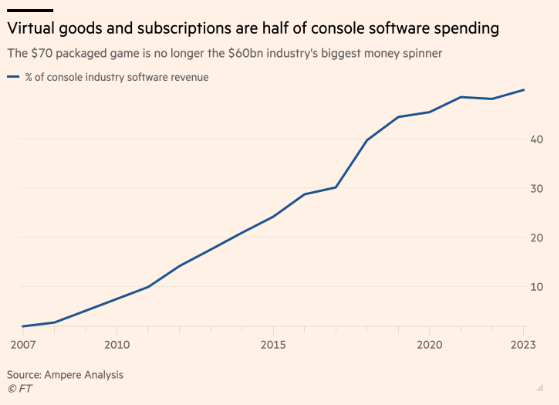Games console industry tries to adapt to rise of free-to-play titles
Virtual goods such as Fortnite weapons and subscription services such as Microsoft’s Game Pass have become as important to the console industry as its traditional money spinner of high-priced standalone games, marking a turning point for the $60bn business.
Console players are set to splash out $21bn on in-game items and subscription services this year — about the same as they will spend on game downloads and discs, according to research group Ampere Analysis.
Such expenditure has risen sharply since the popular free title Fortnite debuted in 2017. Gamers that year spent three times more on console software than on subscriptions and virtual items.
…
“If players continue to gravitate to free games, such as Fortnite, that do not require the latest hardware, Sony will find it more difficult to sell its PS5 to all but the most dedicated of players, some analysts have argued.”
Archived version of the article: https://archive.vn/032BW#selection-2369.103-2373.159




Not really considering the vast majority of people don’t use micro transactions. These companies make money by farming whales who have mental health/addiction issues.
I see this take a lot, and while I don’t disagree… I think it downplays the number of people who DO make ‘sensible’ purchases in a lot of these games.
I personally don’t bother with in-game purchases (I also rarely buy DLC… but I also sub to FFXIV regularly, and have all the content for Destiny 2, so sometimes I can be got) for cosmetics or especially boosts. I’d rather earn the items in game, or a step down, earn in-game currency to purchase those items instead because I’m, at the end of the day, paying for a game to play it and while I want to look good in game while doing so, I’m not gonna drop $15 on digital t-shirts.
But there are plenty of people who don’t mind tossing down $60 additionally a year into a game like Destiny 2 for sparkly new transmog outfits from the Eververse store, and they’ll see it as any sort of reason to do so (‘because I have the money’, ‘because I want to support the developer’, ‘because I have to collect everything’, ‘because because because’), and we can’t just pretend like its a handful of dudes dropping thousands of dollars while everyone else nobly boycotts the practice.
You are correct, but as someone who has worked in F2P mobile for a decade, it is true that most profitability comes from whales, at least in this market. You might have hundreds of thousands who spend as you mention (dolphins or minnows), but as a percentage of revenue, that aggregate is considerably smaller than the aggregate of whales: I’ve seen that ratio as high as 5:95 on a financially successful mobile F2P 4X strategy game, meaning 5% of total revenue coming from players with a lifetime spend of less than $250, 95% of total revenue coming from those above that. The populations of those groups is usually the opposite (very few whales vs. many dolphins and minnows).
Not all F2P models swing heavily into “whale-based”, but the traditional wisdom is similar to the casino industry. Large corporate companies often have small teams dedicated to servicing VIP players, ensuring they come back to the game through attractive offers or other gifts (https://www.gamesindustry.biz/how-does-zynga-hunt-for-whales-this-week-in-business).
Another component that people don’t understand is that often these aren’t “normal people” in terms of their income. We had geo-tagged data, so when you’re looking at your high level VIPs north of a million in lifetime spend, you’re talking about someone in UAE, someone in Petersburg, someone in Hong Kong, or someone in the Texas oil fields. That’s not to provide moral ammunition, but it is a different viewpoint from these games preying on people who don’t have money. A lot of whales have so much money, they just don’t care about spending $100s or $1,000s at a time.
Finally, I personally know at least 1 divorce caused by a game I worked on: the husband couldn’t stop spending, and it led to a separation. There are likely more. By the same token, I also know marriages caused by that same game.
If people are having issues with spending, please stop playing, stop spending, get help. If people don’t want this to be the dominate model, they need to support with their wallets. Having said that, there’s more free games to play than when I grew up. I do think that is pretty cool.
Microtransactions need to be regulated the way casinos are. Companies won’t do the right thing unless they are forced to.